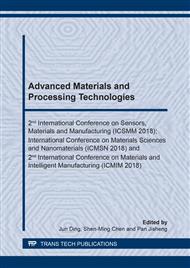p.117
p.125
p.129
p.137
p.145
p.151
p.159
p.167
p.175
Effect of Anodizing Time on Morphology and Wettability of TiO2 Nanotubes Prepared by Carbon Cathode
Abstract:
In this work, titanium dioxide nanotubes (TNTs) were prepared by anodization method with carbon cathode rather than the conventional platinum electrode. The composition of electrolyte and the anodizing voltage was fixed as constant for this research. Carbon plate was used as the counter electrode and the anodizing times were varied for 5 h and 10 h. After anodization, the samples were further annealed at 450 °C to crystallize the as-produced TNTs. Phase composition and morphology were identified by XRD and FESEM, respectively. Wettability of the samples were examined using a contact angle instrument. The results showed that the annealed TNTs were anatase phase with average pore diameter and tube-length of 28.7 nm and 284.6 nm for 5 h, and 30.0 nm and 376.5 nm for 10 h, respectively. The differences in pore diameter and length of the nanotube samples were due to the effect of anodizing time. Wettability of both annealed TNTs was also affected by anodizing time. The surface modifications and wettability results suggested potential applications in biomedical fields.
Info:
Periodical:
Pages:
145-150
Citation:
Online since:
July 2019
Keywords:
Price:
Сopyright:
© 2019 Trans Tech Publications Ltd. All Rights Reserved
Share:
Citation:


